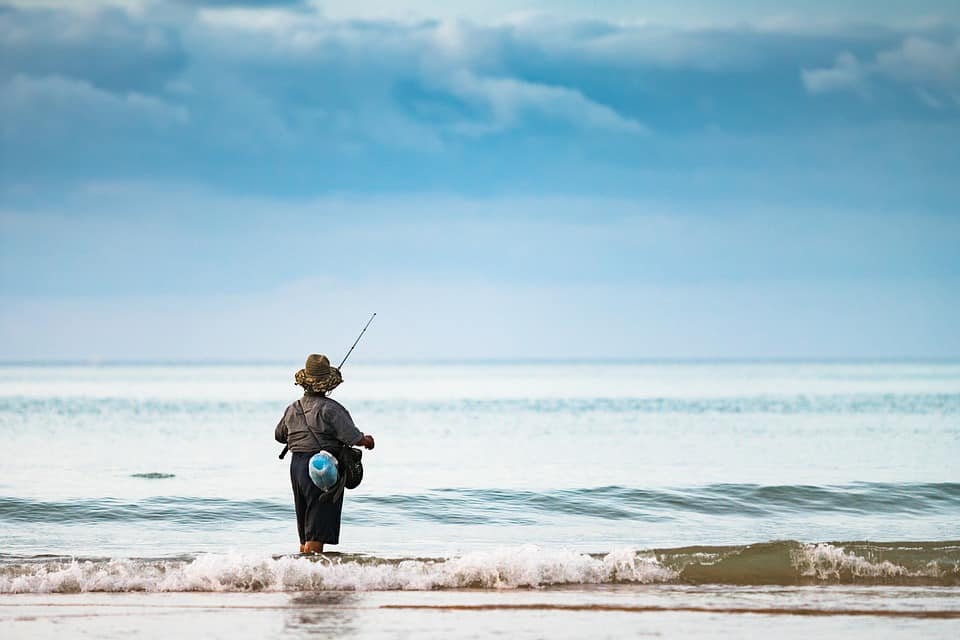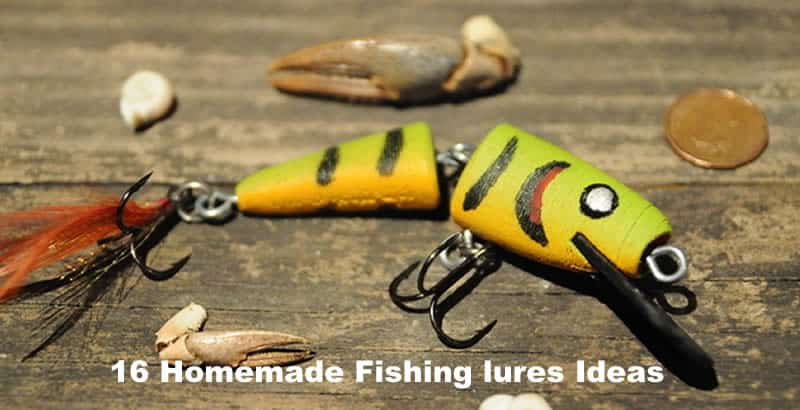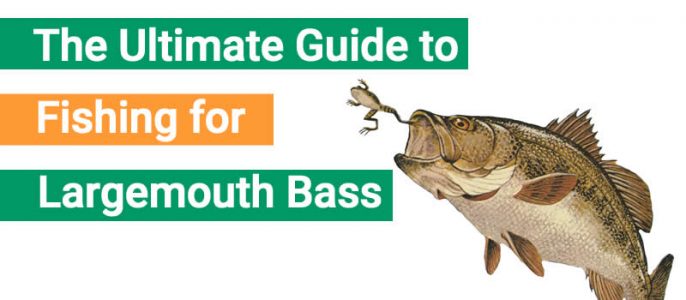If you buy via a link on this page, we may receive a commission, at no extra cost to you.Learn more
Lakes are a great way to spend a weekend fishing, admiring the vistas, and spend quality time with family and friends. So, it is not a surprise when most anglers spend a whole day or two carefully planning the trip.
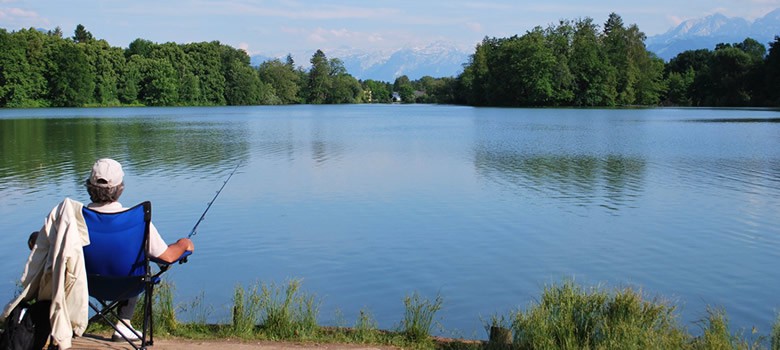
And one thing that you should always keep in mind, even before choosing the lake, is what kind of bait you will use, as your catch rate highly depends on it.
There is an endless discussion about what is the best bait for lake fishing. Ultimately, the answer to this question depends on the type of fish you are pursuing. Furthermore, different anglers will have different answers. But we’ve found that power bait and worms are two of the best baits you can find. The first is more for target-specific fishing, while the latter is a general-purpose bait.
However, you can also use:
- Insects – An irresistible snack for smallmouth bass, panfish, and trout
- Doug balls – An inexpensive solution to catch some carp, trout, and even catfish
- Salmon eggs– The caviar for salmon, trout, and steelheads
- Chicken livers – For catfish
- Corn – For perch, carps, and bluegill, make sure it is legal first
You already know what you should stick at the end of your line. But do you know how to rig it? If not, don’t worry. We’ll take a couple of lines to show you how.
Power Bait
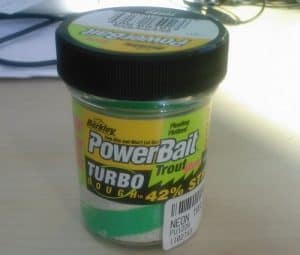
Power bait is widely known and used by anglers of all experience levels. You can purchase a jar in any tackle store, and it either comes as a dough or solid with many different colors, sizes, and flavors.
The distinctive feature of power baits is that they are tailor-made depending on the fish that you wish to target. But this doesn’t mean that if you are using a power bait for trout, it won’t attract bass. It means that you will have higher chances of landing trouts than any other species.
Another huge advantage is that some of these power bait float on water. This way, fish can easily see it, and the hook will stay away from debris, weed, or any other underwater structure.
With that out of the way, let’s talk about how to rig power bait.
How to Rig a Hook with Power Bait
If the power bait comes as pellets or tiny balls, you merely need to poke one with the hook. It is quite easy to pierce the ball as it is very soft. Some people recommend filling the entire gap with power bait. But it is not necessary.
The dough presentation is a little messier to use but equally effective. Grab some of the paste with your fingers, make a small ball. Then, cover the hook with it. Don’t be picky; add enough power bait. Otherwise, the hook will sink, or the ball will come apart after a few bites.
Worms
The good ‘ol worms. They are the universal freshwater bait. Thus, every person that calls him/herself an angler ought to know how to fish with worms. A handy rule of thumb when using this type of bait is to use larger ones for big fishes and so on.

Tackle shops thrive with worms of different sizes and colors. But the most common is the classic nightcrawler. They are quite large and have a natural scent that drives fish crazy, a solid choice when it comes to lake fishing bait.
Another option is wax worms. They are ideal for beginners, as they are not as slippery as earthworms or nightcrawlers. We recommend using this type of worm as bait for perch, crappie, trout, and sunfish.
Yes, we know many people find worms repulsive. Therefore, you might have a hard time to rig them to your line. But don’t worry. Here we will show a couple of easy ways to hook them.
How to Rig a Hook with Worms
How to rig the worm depends on the fish you are trying to land.
For small fish, grab a little worm, or use half of a large one. Then, pass the hook through either end. Squeeze it until you get to the eye of the hook, and leave the rest hanging. This way, it will draw the attention of any fish lurking beneath the waters.
Now, if you are looking to land some bottom feeders such as catfish, you need to grab a massive worm. Then, pierce its head with the hook and squeeze it to the end of the gap. Take the rest, wrap the hook, and poke it again. Repeat this step until the gap is full or you run out of bait. The goal here is to make the hook look bulky enough to catch the fish’s attention.
Lastly, for game fish such as bass, grab a large worm. Poke it with the hook, and squeeze it to the eye. Then, grab the tail, make a loop, and pierce it again; repeat this a couple of times. Finally, leave the rest of the bait dangling.
Insects
As worms, anglers have been using insects as bait for a long time now. Beetles, grasshoppers, and crickets are among the most common bugs that you can use as bait on your next trip to the local lake.
The obvious advantage is that you can find most insects, especially grasshoppers and crickets, in your backyard or even in the lake. Alternatively, you can purchase them at any tackle shop.
Thanks to the fact that lakes don’t flow as rivers do, food sources are sometimes scarce. As a result, fish are likely to target anything that looks like food, including insects.
But we’ve found that smallmouth bass and sizable trouts like hellgrammites and dobsonfly larvae the most.
How to Use Insects as Bait
The hooking method depends on the type of bug you attempt to use. But we recommend passing the hook through the neck, as it is usually the strongest point. It will eventually kill the bug, but fish will still love it and try to eat it.
Dough Balls
Dough balls are a quick, yet reliable solution for bait. And the best thing is that you can make them on your own! Here is the process:
- Mix equivalent cups of flour cornmeal. Then, add some sugar to the mixture.
- Pour enough water to make a homogenous dough.
- Start making small balls with the dough.
- Add water, sugar or honey, and a flavoring agent such as garlic. Mix everything.
- Now, add the liquid mixture in a pan and boil it.
- Finally, add the balls to the boiling mixture and cook for 5 minutes.
Some people just make the dough and use it without cooking. You can use whichever you like.
They are also commercially available in a wide range of flavors and scents intended to attract specific fishes. You might know it under the name of power bait. Yes, the same one we previously talked about.
How to Use Dough Balls as Bait
It is quite simple. Gently grab the dough balls and push the hook through it. Don’t push too hard, or you will tear the ball apart.
If you have a paste instead of a dough ball, you merely grab enough paste to cover the entire hook. Make sure to completely wrap the shank, the gab, and the barb. Again, press the paste gently, or you will get yourself hooked.
The biggest disadvantage of fishing with dough balls is that they disintegrate when in contact with the water. And jerk the rod will only accelerate this process. Thus, we recommend using this type of bait if you like to cast and sit still waiting for a bite.
Salmon Eggs
Salmon, trout, and steelhead find salmon eggs irresistible. These eggs are especially effective during spawn season, when these fishes are more active.
You can purchase them in almost any tackle store. But you can also harvest from salmon. Remember to cure them once you do, though. Otherwise, the eggs will quickly rot. Don’t worry, it is not a difficult process, but it does require time and some tools.
How to Use Salmon Eggs as Bait
Because salmon eggs are delicate, sticking them to the hook is not as easy as with the others.
If you are using loose eggs with a small hook, you can grab each one and merely poke them with the hook. However, to increase effectiveness, we recommend a special mesh sheet. Then, place the eggs according to the fish you are pursuing. For example, use 20 eggs or more if you want to land a big salmon or trout.
Now, grab the corner of the mesh and make a small bag. Tie the corners together with some thread, and the bait is ready. All that is left is to hook and secure the bag.
Alternatively, you can use a salmon skein. In this case, you can directly fix the cluster of eggs to the hook.
Chicken Livers
If you love to catch catfish, this bait has no match. It is stinky, is easily visible, and is meaty. Exactly what catfish love.
And the best thing is that chicken livers are widely available in the market. You can find them in supermarkets, some tackle shops, and even in butcher shops. Plus, they are not expensive at all.
The downside is that the scent runs out after 20-30 minutes. Thus, if you haven’t landed a catfish by then, you should change the liver and cast it again.
How to Use Chicken Liver as Bait
If you ever touched any liver, you should know that it is quite soft. So, it is a little bit tricky to keep it in the hook.
The first way to rig a chicken liver is to cut it into tiny pieces. Then, poke the chunk with the hook, and that is all.
Some anglers take the whole liver and wrap it with a piece of thread, creating a tight meant package. Then, all that you need to do is to pass the hook through it, as simple as that.
Keep in mind that you should keep the livers cold at all times. They will get too soft otherwise, and it will lose all the liquids.
Corn
Corn is a superb fishing bait! Many different fishes love corn, especially carp. However, bear in mind that it is illegal to use it in some lakes, especially if you are chumming it. Thus, make sure to read the local regulations to avoid any fees and unpleasant surprises.
Corn is available in any convenience store or supermarket. And you can also find artificial corn baits in most tackle shops.
How to Use Corn as Bait
The biggest downside of corn is that it is quite small. Therefore, it is not easy for fish to spot it. You can solve this by sticking several grains into the hook until you fill the entire gap.
Alternatively, you can use a hair rig to keep some corn dangling in the hook. This way, you will prevent nuisance fish from stealing your bait.
You can also use a PVA bag in combination with a hair rig. A PVA bag is, as the name suggests, a bag that has the ability to dissolve in water. So, it will release the bait underwater and attract nearby fish. This is especially useful in those lakes where you can´t practice chumming fishing.
Time to Hit the Road
No matter if you are fishing on a lake, river, or at sea, having the right gear and set up is crucial. Thus, take enough time to plan what you should bring. Otherwise, you will spend countless hours sitting still without catching anything.
The bait is among those things that you have to take care of. In our opinion, you can´t go wrong with either worms or power bait. First, you can target a wide variety of fish with them, and both are widely available in any tackle shop for a decent price.
But you can also use insects, dough balls, salmon eggs, chicken livers, and corn. However, these are more target-specific, while worms are all-round bait. Feel free to share your thoughts on the matter with us. We will love to hear them!

